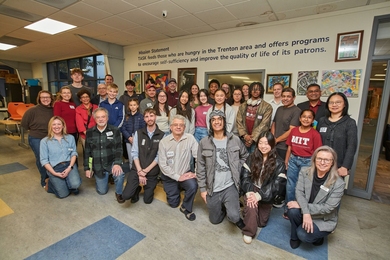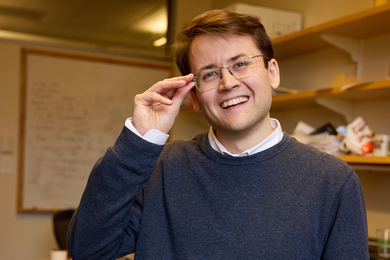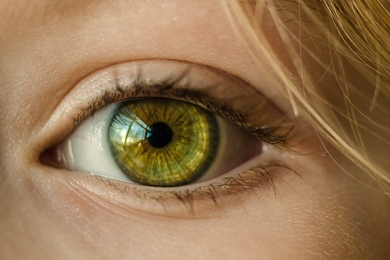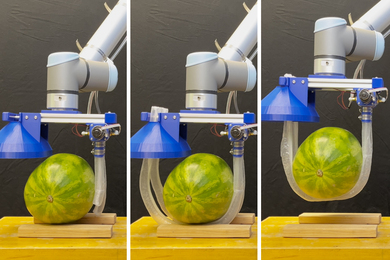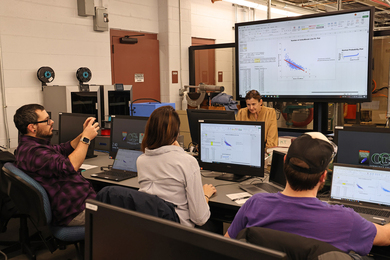Robert W. Mann, an engineer and former rocket scientist who developed the world's first biomedical prosthetic device, died Friday, June 16, of a heart attack. A longtime resident of Lexington, Mass., and Moultonborough, N.H., Mann was 81.
Mann joined the MIT faculty in 1953, serving as a professor of mechanical engineering for almost 40 years. During that time, he also served as Whitaker Professor of Biomedical Engineering and as director of MIT's Eric P. and Evelyn E. Newman Laboratory for Biomechanics and Human Rehabilitation from 1974 until his retirement in 1992.
Mann will "certainly be missed tremendously. He was a leader in the field of design in the true sense of the word. He was instrumental in turning design into a discipline. Bob was deeply engaged in the department in very positive ways until the very end, attending our bi-weekly faculty luncheons without fail," said Rohan Abeyaratne, head of the Department of Mechanical Engineering.
Born in 1924 in Brooklyn, N.Y., Mann attended Brooklyn Technical High School, after which he entered the U.S. Army, serving in the Pacific Theater in World War II.
He came to MIT as a student on the GI Bill in 1947, and received the S.B. degree in 1950, the S.M. in 1951 and the Sc.D. in 1957.
During the 1950s, Mann conducted research on internal power systems that led to the development of Sparrow I and III and Hawk missiles. By the mid 1960s, his research was focused primarily on applying technology to human disabilities.
In a 1997 talk at MIT about his fruitful career, Mann characteristically combined modesty with enthusiasm in describing how he made the switch from "powering rockets to powering people," as he put it.
A fellow veteran who had lost his sight and one arm in the Battle of the Bulge inspired Mann's first applications of technology to help people with disabilities. Collaborating with John Kenneth Dupress, the blind veteran, and others, Mann inaugurated the Sensory Aids Evaluation and Development Project in 1964. English-to-Braille computer translation systems, the award-winning MIT Braille Embosser and electronic travel aids for the blind resulted from that project.
Helping the disabled
Next, Mann applied his knowledge of computer-aided design -- another area in which he was a pioneer -- to his experience with powering rocket systems and his commitment to helping those with disabilities.
"You don't have to be a rocket scientist to see even an amputated arm still has muscle [above the lost limb], which the brain still directs," Mann said once, referring to the electrical impulses that connect the brain and muscles and that can also "power" biomechanical devices. Mann's Boston Arm was the first artificial limb to rely on a combination of biology and technology for its control.
Mann's studies of skeletal joints and osteoarthritis, together with related computer-aided imagery, have explicated the biomechanical role of cartilage and include the only measurements of pressures on and in cartilage in vivo in the human hip. He designed a caliper-like sizing device to make sure the replacement ball used in hip surgery fits perfectly.
"I'm an engineer. The way we think, a bone is a link; a joint is a bearing; a muscle is an actuator; ligaments and tissues are springs," Mann said about his lifelong approach to design challenges. Throughout his career, he credited Brooklyn Tech for providing him "superb preparation in good, practical arts -- foundry, forge and machine shop."
While teaching and mentoring graduate students at MIT, Mann was also involved in development of the Utah Elbow and the MIT Knee, along with Pappalardo Professor of Mechanical Engineering Woodie C. Flowers (Ph.D. 1972), then a graduate student.
Mann's service to MIT was as dedicated and innovative as his research on biomechanics: He was devoted to teaching, advising for more than 300 theses at MIT, and to nurturing the Institute's sense of community. He and his family opened their home to students for an annual chicken dinner, his daughter, Catherine Mann (Ph.D 1984), recalled.
Mann transformed the design curriculum in mechanical engineering at MIT in the 1960s by introducing project-oriented courses, involving students in the entire design process.
In 1983-84, Mann served as president of the Association of Alumni and Alumnae of MIT, only the second faculty member to so serve in the 20th century. He also served as president of the Class of 1950 for 50 years.
Awards and honors
His contributions have been acknowledged at MIT through the award of two endowed chairs and his receipt in 1983-84 of the James R. Killian Jr. Faculty Achievement Award, established to "recognize extraordinary professional accomplishments of full-time members of the MIT faculty."
He also received the Bronze Beaver in 1975, the highest honor awarded by the Association of Alumni and Alumnae.
Outside MIT, Mann's contributions were numerous. He was a member of the Advisory Committee of the National Braille Authority. Within the National Research Council he was a member of the Committees on the Skeletal System and Prosthetics Research and Development and founder and chair of the latter's Subcommittee on Sensory Aids.
Mann served as director and president of the Carroll Center for the Blind, trustee and president of the National Braille Press, and as consultant on engineering science at Massachusetts General Hospital, among other roles.
Mann was elected to the National Academy of Sciences, the National Academy of Engineering, and the Institute of Medicine -- one of fewer than 10 people to receive all three of these awards.
He was a fellow of the American Society of Mechanical Engineers, the Institute of Electrical and Electronic Engineers, the American Academy of Arts and Sciences, the American Association for the Advancement of Science, and the American Institute for Biological and Medical Engineering.
Mann met and married the former Margaret Florencourt, a researcher at MIT on the Whirlwind Computer Project, in 1950; she died in 2002.
He is survived by a son, Robert Jr. (S.M. 1977), and daughter-in-law, Susan, of Port Washington, N.Y.; a daughter, Catherine and son-in-law, Randy Hartnett of Great Falls, Va; two sisters, Virginia Swartz of Pittsburgh, Pa., and Helene Madigan of St. Paul, Minn.; a brother, Kenneth, of Burlington, Vt.; and four grandchildren.
The funeral will begin from the Douglass Funeral Home, 51 Worthen Road, Lexington, on Wednesday, June 21, at 9 a.m. A funeral Mass will be celebrated at 10 a.m. at St. Brigid's Church, Lexington.
Visiting hours will be Tuesday from 4 to 8 p.m. at the Douglass Funeral Home.
In lieu of flowers, donations may be made to the Flannery O'Connor-Andalusia Foundation, P.O. Box 947, Milledgeville, Ga. 31059. Interment will be in Memory Hill Cemetery, Milledgeville, Ga.



